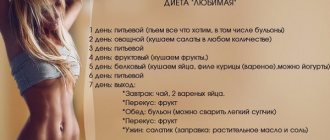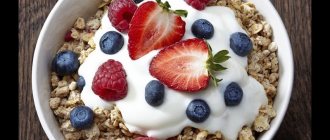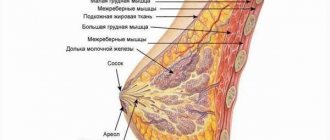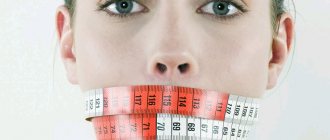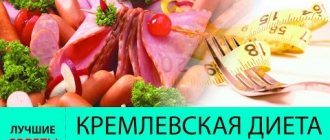Cleansing diet
We can’t start losing weight until we cleanse our body of toxins. This way we can not only lose a few kilograms, but also improve our health.
On average, on this diet you can lose 2-3 kilograms in the first week. In a month you can see -10 on the scales.
A weekly diet for weight loss includes the following products:
- Products of plant origin.
- Almost all porridges do not contain added oil.
- Whole grain baked goods.
- Low-fat dairy products.
- Poultry, lean beef, fish.
The menu looks like this:
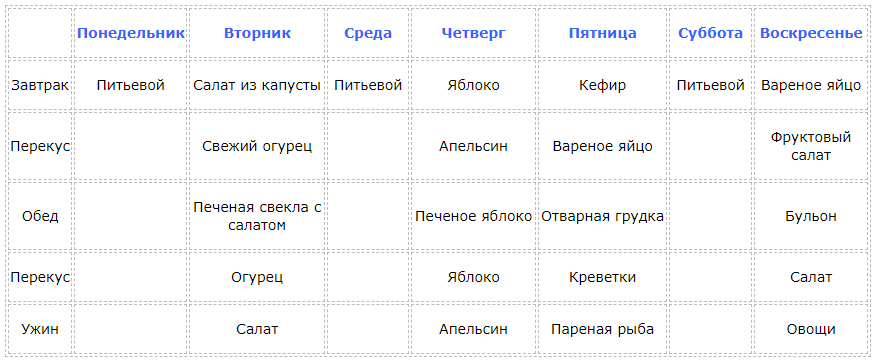
This is an effective diet for losing weight at home, and it’s not very expensive. By the way, don’t forget to drink at least 2 liters of water a day.
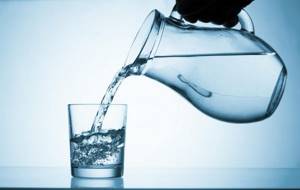
Menu for the week
Thanks to a properly designed menu, you can quickly lose weight at home - and the food can be the simplest, but tasty and healthy. Our budget diet option will help make your figure slim and at the same time save your finances. The caloric content of this nutrition plan is calculated at 1200-1400 calories per day.
Prescribed nutrition is the best way to avoid breakdowns. Try not to deviate from your prescribed diet, because even a slight excess of the daily calorie intake can stop weight loss.
1st day
Morning: 150 g cottage cheese casserole, orange
Snack: bread with a piece of cheese and herbs
Lunch: 150 g vegetable soup, 100 g chicken fillet
Evening: 200 g chicken liver, stewed with vegetables and herbs
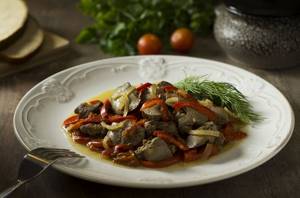
2nd day
Morning: 150 g oatmeal with apple slices
Snack: baked apple with cottage cheese
Lunch: 200 g beef in tomato sauce, stewed with red beans
Evening: 200 g salad with chicken fillet and vegetables
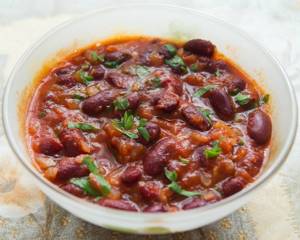
3rd day
Morning: 100 g lentils, boiled egg
Snack: 150 ml kefir 1% fat
Lunch: pumpkin cream soup, boiled egg
Evening: 100 g baked pollock, 100 g stewed cabbage

4th day
Morning: whole grain toast with cottage cheese and herbs
Lunch: 150 g fish casserole with broccoli, 50 g buckwheat
Evening: 100 g boiled beef, baked eggplant with cheese

5th day
Morning: 2 boiled eggs, toast with whole grain bread and tomato
Snack: 100 g cottage cheese with a handful of raisins
Lunch: 150 g steamed chicken cutlets, 100 g of any vegetable mixture (frozen will do)
Evening: 150 g baked hake, 100 g vegetable salad

6th day
Morning: oatmeal pancake with chicken breast and cheese
Snack: 150 ml smoothie with apple and kefir
Lunch: 100 g boiled beef, 70 g brown rice, vegetable salad
Evening: 100 g boiled chicken hearts, 100 g salad with cabbage and cucumber
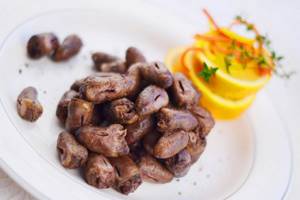
7th day
Morning: 2-egg omelet, slice of whole grain bread, greens
Lunch: 100 g chicken meatballs with brown rice, 100 g vegetable salad
Evening: 100 g boiled fish, 100 g vinaigrette
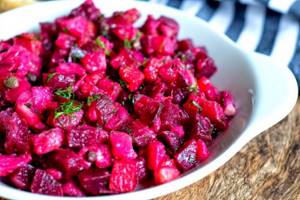
Low calorie diet
Not a bad diet to lose 5 kg in a week. Even though we're cutting calories, you definitely won't leave hungry. We limit ourselves to carbohydrates, which contribute to the deposition of fat.
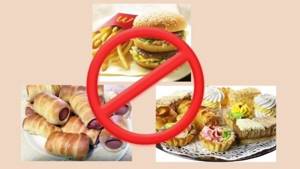
The weekly diet allows you to eat:
- Wholemeal buns and bread.
- Meat and fish.
- Any fermented milk products without sugar.
- Porridge, with the exception of semolina and rice.
- Any fruits and berries.

A diet for losing 6 kg is based on 5 rules:
- We focus on low-calorie, high-protein foods. We need this to maintain muscle mass and burn fat.
- We keep carbohydrates to a minimum (1.5 grams per kg of weight).
- We divide the food into 5 doses of 100-300 grams.
- We reduce the salt so as not to cause swelling.
- We exclude alcohol, as it increases appetite.
- We drink more water.

The 7-day diet is effective, but not debilitating. You will feel good, and hunger will not haunt you.
A sample menu looks like this:
- Breakfast. Buckwheat and apple.
- Snack. Vegetable salad.
- Dinner. Vegetable soup with meat.
- Snack. Cottage cheese.
- Dinner. Baked hake with vegetables.
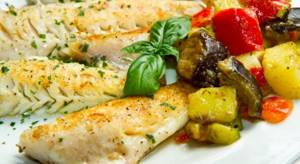
Features of the diet for the year
To move towards your goal, you need to create a table in which all changes in weight, training schedule and caloric intake will be entered. When calculating and creating weight loss plans, it should be taken into account that losing weight by 1–1.5 kg per week is the maximum permissible limit. Losing pounds too quickly negatively affects metabolic processes and is bad for health.
- calculate the difference between your existing and desired weight, divide it by 12 (according to the number of months) and write down the resulting number - the figure corresponds to the number of kilograms that need to be lost monthly;
- plan rewards for yourself for fulfilling your plan;
- Completely review the principles of nutrition, analyzing the calorie content and harm of each dish - this will help determine ways to reduce calories consumed by removing harmful and “heavy” foods from the diet.
The strategy for using a long-term diet for weight loss is to lose weight through a transition to proper or dietary nutrition (separate, vegetarian, etc.).
Basic diet rules:
- you need to eat often (at least 5-6 times a day) in small portions;
- consume calories per day in the amount necessary for normal well-being - this can be determined using data on the calorie content of foods;
- give up fast food and not eat junk food (fried, fatty, salty, smoked, etc.), and in the first month it is better to eat only at home (this will allow you to regularly check the calorie table and weight of foods);
- limit the consumption of sweet and starchy foods (possible, but rare);
- have dinner at least 3 hours before bedtime, trying to include light foods (for example, an apple and tea).
Kefir diet
The kefir diet for weight loss is very common, if only because it does not have clear restrictions. Its calorie content is very low. For example, 100 grams of 1% kefir contains only 40 kcal.
To lose weight you need to drink 1.5-2 liters a day. Divide the volume into 6 doses and pour into small bottles.
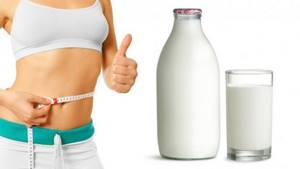
A kefir diet for 7 days gives a good result - 5 or more kilograms.
Basic diet rules for a year
Most modern diets are aimed at quickly getting rid of extra pounds, but often grueling fasting leads to a deterioration in the functioning of various body systems, and the weight returns to its original level. In this regard, nutritionists advise creating an individual diet for the year. The correct choice of diet helps eliminate excess fluid from the body, remove toxins and break down fats, normalize metabolism and the functioning of the digestive system.
Thanks to a diet for a year, even people who are very overweight become slim. Plus, their body becomes stronger and their health improves. A balanced diet for weight loss is based on a special nutrition plan. It contains organic acids, fiber, microelements, and vitamins. As a result, you can lose even 20 kilograms in 1 year.
Protein diet
If you need to lose minus 10 kg in a week, a protein diet for quick weight loss is definitely suitable. Yes, it is quite heavy and we completely cut out fats and carbohydrates. We leave lean meat, poultry and fish in our diet.
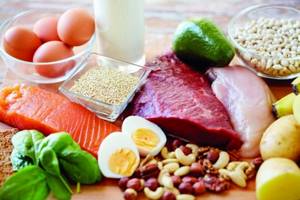
Attention, a diet of minus 5-10 kg per week is not considered healthy and for people with gastrointestinal problems (lack of enzyme for protein digestion) or unstable blood sugar, it is strictly prohibited.
Naturally, we don’t eat fried or fatty foods. Frying is strictly prohibited; it is better to bake or boil. By the way, this diet is often chosen because of its delicious menu. Hunger is almost invisible, and many dishes can be ordered in cafes or even food delivery.
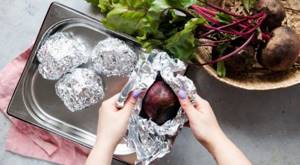
First of all, we refuse:
- Sahara. This is a pure, fast-acting carbohydrate. It immediately breaks down into glucose and enters the blood. We remove it in any form.
- Pastries, cakes. They contain a lot of refined sugar.
- Fatty fermented milk products.
- Prepared canned meat, fruits and vegetables. They are half fat, which is not needed in our diet.
- Semi-finished products. To gain weight, store-bought cutlets, dumplings, and khinkali are filled with cheap starch, which is a carbohydrate.
- Starchy vegetables. Potatoes, carrots, legumes, corn. They have a lot of starch and are high in calories.
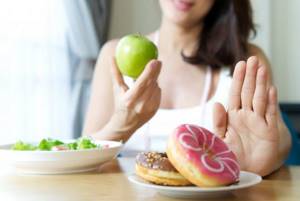
You can lose 5 kg in a week if you follow simple diet rules. We eat regularly, 3 times a day. It is better to eat at the same time so that the body gets used to it and does not feel hungry.
For each meal we allocate 150-200 grams of meat or fish. Of course, you can’t do without a side dish. You can make salads from: tomatoes, cucumbers, lettuce, arugula, broccoli, cabbage. You can dress the salad with soy sauce, lemon juice, balsamic or wine vinegar. You need to be careful with acidic dressings. Poor nutrition may increase acidity.
It is important that diets for weight loss at home are allowed within 1-2 weeks. Later, flatulence, bloating, and dyspepsia may begin.

We drink at least 2 liters of water. You can have tea or coffee. We can't eat sugar, but sweeteners are quite suitable, since they are devoid of calories.
Advantages and disadvantages
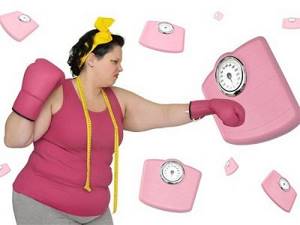
With the help of a strict diet, you can lose from five to seven kilograms of excess weight in just one week. This is one of its main advantages. The second advantage is that you will need a minimum of products, that is, losing weight is considered budgetary. You won't have to spend a lot of money on food. Cooking food will take a minimum of time. Properly selected foods and a strict diet can sometimes cure patients suffering from psoriasis or various types of diathesis.
This is where all the pros end and the cons begin. One of the most important is that those who follow such a diet will constantly experience a painful feeling of hunger, which usually causes severe irritation and worsening mood. But that’s not all: nutritionists persistently prohibit this diet, citing the fact that it causes stomach problems and sometimes leads to anorexia. Stomach pain, rapid fatigue, headaches are constant companions of a long-term strict diet.
Vegetable diet
You can lose maximum weight in a week if you reduce calories to the minimum level. A vegetable diet will help us here. In fact, it is quite diverse and has 3 versions:

- Strict. Only vegetables are allowed, and non-starchy ones. Cucumbers, tomatoes, lettuce, onions, cabbage - this is your diet for the whole week. You can cook them however you like. If you fry, do not add oil.
- Moderate. Add cereals and some nuts to the vegetables. Most women choose the moderate form, since without fat, hormonal imbalances can begin.
- Mixed. We introduce a small amount of dairy products into the diet. Low-fat cottage cheese, milk, kefir, fermented baked milk are also low in calories, but contain protein and milk fats. This diet will give you minus 5 kilograms for a week.

Losing weight in 7 days on such a diet is not difficult, because it is impossible in principle to overdo it with calories.
Watermelon-melon diet
You can diversify your melon diet by adding watermelon to your diet. The consumption of products will need to be alternated throughout the day. The principles of the watermelon-melon diet program do not differ from the main version. You can follow a strict diet for several days or introduce melons and watermelons into your daily diet for two weeks.
It is recommended to replace breakfast and afternoon snack with products. The rest of the meals are complemented with them as dessert.
Additional principles of the watermelon-melon diet:
- During the diet, you must stop drinking alcohol;
- Flour products, sweets and hard-to-digest foods should be excluded from the diet;
- it is allowed to eat rice, beef, turkey, chicken, legumes, vegetables and fruits (the exception is fasting days on the watermelon-melon diet, during which the consumption of other foods is prohibited).
Rules for quitting homemade diets without health risks
Even the most popular weight loss diets are not designed to be followed for life. The body needs balanced food, vitamins, fats, and a variety of foods so as not to lapse into fast carbohydrates. If you want to maintain a slim figure, a proportionate body, clear skin, then get used to denying yourself excess. It is possible to safely return to a full menu only gradually.
The main rule that unites all the best diets for weight loss is not to return to your previous eating habits. Add one product per day, don’t forget about nuts, sweet fruits, and fatty fish. Join a gym and work out at least 3 times a week. Sport will help you maintain your new body quality and tighten your muscles. The longer the diet was, the slower the body will recover. Don't overeat. If you feel very hungry, drink a glass of warm water. Continue to eat 5 small meals a day. Gradually, you will not notice how proper nutrition becomes habitual, and forbidden foods are not as tasty as before. Don't forget that regaining your previous weight is easy, but losing it again will be twice as difficult.
IMPORTANT ! Informational article! Before use, you should consult a specialist.
Photo of diet for weight loss
Look: Vegetarian diet: menu for every day and features of food selection (75 photos + video)
Help the project, share on social networks 

0
Eight of the most fashionable diets in the world
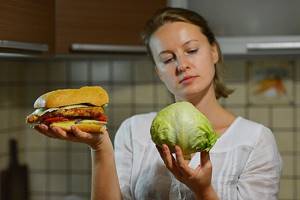
Here are the eight most popular diets in the world
Photo: Oleg RUKAVITSIN
Here are the eight most popular diets in the world (according to surveys of nutritional associations from Europe, the USA and Russia). Let's try to figure out what functions of the body they are based on and whether they are as useful as their inventors claim.
1. Don't eat after 6 pm
This is probably the most popular diet in the history of nutrition. Moreover, the “don’t eat after 6 o’clock” attitude is not the limit. Some people use the “don’t eat after 5 hours” variation (it’s scary to talk about the fanatics of the “don’t eat after 4 hours” modification). The ban on eating after six is explained by the fact that in the evening the body is no longer engaged in digestion. That is, everything that gets into us after six simply gets stuck in the stomach, and as soon as we fall asleep, it is stored as fat. In addition, physical activity drops noticeably in the evening, so all the calories remain with us.
Actually Actually
The digestive organs work even when a person is sleeping, and, moreover, food is absorbed better at rest than during active work. Moreover, at night, adipose tissue is mainly absorbed. So the principles of this diet have nothing to do with the actual human metabolism. In addition, this diet does not in any way correlate with one of the most important tenets of a healthy diet - fractional meals, that is, eating in small portions 5-6 times a day.
The habit of not eating after six is perceived by the body as starvation, and it immediately slows down the metabolic process and stores fat in order to store up energy for a very rainy day. Professor of the Department of Clinical Immunology Jean-Claude Melchior in his study demonstrated that breaks between meals of more than 12 hours (even during night sleep) reduce the effect of treatment in obese and overweight patients by almost 80%. In addition, during long breaks in food, bile stagnates, forming gallstones. So by strictly prohibiting yourself from touching the refrigerator after 6 pm, you risk ruining your digestive system and developing cholecystitis.
2. Low carb diets
Already from the name it is clear that the meaning of this diet is to reduce carbohydrates in the diet, which are the main source of quick energy. According to supporters of this diet, by receiving carbohydrates, the body ignores the breakdown of fats, which are then safely deposited on our sides. Products with a high sugar content are prohibited: sweets, juice concentrates, syrups, honey. In addition, products that contain starch, flour, and sucrose are removed. In general, it’s better to say goodbye to bread and potatoes.
Actually Actually
Indeed, foods containing simple carbohydrates can contribute to obesity, but no more than regular fatty foods. According to Robert F. Kashner, MD , the theory behind the low-carbohydrate diet is based on false information that the breakdown of carbohydrates completely blocks the breakdown of fats.
In fact, both occur in a precise balance. By the way, when working out or during an active life, carbohydrates are the most preferred means of restoring energy, and, in addition, they are vital for brain function. And yet, data collected by students at the University of Calgary showed that young people who eat fatty foods more often are more susceptible to stress and cardiovascular disease. In general, everything is good in moderation.
By the way, in this same part it is worth mentioning a low-fat diet, which is a mirror image of a low-carb diet. The explanation for why such a diet should be approached with caution is the same: balance, balance, balance.
3. Kremlin diet (Atkins diet)
One of the most common diets is a type of low-carbohydrate diet. The basic principle of the Kremlin diet is that, in addition to limiting fats and carbohydrates while eating plenty of protein, each product is assigned a certain point, and you need to eat so as not to exceed the allowed number of points per day. Points can be found in special tables and, purely arithmetically, any diet that does not exceed the permissible values can be compiled. If you want to lose weight, you can’t score more than 40 points; to maintain weight, don’t score more than 60 points, and so on. The maximum weight loss effect is achieved with a varied diet consisting of acceptable, mainly protein foods.
Actually Actually
Indeed, protein is the building material of our body, and its benefits are undeniable. And indeed, with the help of that diet you can lose weight. However, a diet consisting of protein, which is added to the diet by arithmetic scoring, is not so safe for health. During the digestion of protein, harmful substances are formed, which are normally destroyed in the liver and excreted through the kidneys.
However, according to the standard guide to the body's nutritional needs, the daily protein requirement is 1.5 grams per kilogram of weight, that is, a maximum of 100-120 grams of meat per person. So when you consume too much protein, these systems take a serious hit!
In addition, meat does not contain fiber, which is necessary for intestinal function, and does not contain many microelements that our cells need. You could argue that the Kremlin Diet doesn't prohibit other foods, but the points table won't allow you much variety. In general, if you decide to resort to the Kremlin diet, first talk to your doctor to see if you are healthy enough for it.
4. Separate food
Separate nutrition is based on ideas about the compatibility of foods and the harmfulness of certain combinations. The concept of compatibility is based on ideas about the characteristics of the digestion of different foods in the stomach, their different digestibility and the adverse effects of mixed foods on human health. For example, you cannot eat proteins and carbohydrates at the same time, because their digestion requires different conditions: an acidic environment for proteins and an alkaline environment for carbohydrates. And so on.
Actually Actually
In principle, there is nothing wrong with the very idea of separate nutrition. The body can get used to anything, however, the benefits of such a diet are highly controversial. According to nutritionist Svetlana Fus , separate nutrition does not make sense simply because human physiology is configured to consume mixed foods - the enzymes that are secreted by the digestive organs have a mixed structure and work all at once, regardless of what we eat.
The statement that proteins require an acidic environment, and carbohydrates require an alkaline environment (which is true in principle) does not take into account the universal regulatory systems of the stomach, which cope well with the assigned tasks. In addition, in nature there are no products that consist only of proteins, fats and carbohydrates. Almost everywhere there are a variety of components, so separate nutrition cannot have any practical meaning, remaining rather a theoretical fabrication.
5. Raw food diet
You cannot cook, fry, steam or stew food - at temperatures above 30 degrees, almost all beneficial substances are destroyed. In addition, ancient man never ate fried or boiled food, and felt great, so raw food is the most natural for the human body. This is the main idea of proponents of a raw food diet. However, they allow dried food without added salts and seasonings, for example dried fruits, sun-dried meat, sprouted cereals (wheat is especially respected). However, at the same time – no stove!
Actually Actually
In fact, this point of view has a right to life. Indeed, it is very useful to eat vegetables and fruits fresh, but eating only vegetables, fruits, berries, nuts and seeds is not exactly what the human stomach is designed for. We need meat, and, of course, dried or salted meat can also be suitable, but thermal treatment, firstly, activates some of the beneficial substances, and secondly, neutralizes harmful substances and kills microorganisms that settle in meat products, as if neither stored.
Dietitians consider the transition to a complete raw food diet to be extreme, and suggest that raw food lovers cook at least 40% of their food over fire: meat or fish, potatoes. Of course, it is possible to develop a 100% raw menu that will not cause harm to health, but residents of a metropolis can afford to eat approximately 10% of the products purchased in the store raw due to the harmful substances with which they are processed during cultivation, transportation and storage.
Dairy products sold in the city store are already heat-treated to one degree or another and many of them contain artificial chemicals. Dried fruits and nuts sold in stores are thermally dried and certainly not in the sun. And one more thing - thermal processing does not affect the calorie content of food. Therefore, there will be no loss in the energy value of foods if you boil them a little before eating. However, this is not an acquired taste.
6. Diet "Traffic Light"
A diet for those who don’t want to count calories. Initially, it was based on separating products by color (red - meat, watermelon, red pepper; yellow - lemon, banana; green - dill, green apples, and so on) but, due to the obvious absurdity, the principle was replaced. Now red color represents foods that are definitely prohibited for consumption, yellow – foods that can occasionally be included in the diet, green – foods that should be consumed first.
As a result, the diet is a low-calorie menu with a lot of vegetables and a limited amount of lean sources of protein and fruits and a ban on fat-containing foods. Very similar to recommendations for healthy eating.
Actually Actually
The principle by which products are assigned to one or another “color” is not at all clear. For example, animal fat is classified as “red”, but on what basis? The lack of animal fats leads to disruption of the cardiovascular system and disruptions in the endocrine system. Moreover, the fatty acids that are contained in “forbidden foods” are simply necessary for brain function and human hormonal balance. It’s not for nothing that they are sold in pharmacies as food additives.
A team of researchers led by Dr. Penelope Elias from Boston University examined 789 men and 1,105 women and found that the less cholesterol a person has in their blood, the more problems they may have with thinking and remembering information. Also unclear is the distribution of vegetables on the lists and the limitation of strawberries, blueberries and blueberries - these are the berries that are considered components of a healthy diet. In short, ill-considered distribution of products will lead to disruption of the body's functioning, limitation of useful components and create a bunch of unnecessary problems that will not improve your health in any way.
7. Diet according to blood type
This diet was created by American naturalist James D'Adamo . According to him, food is not equally beneficial for people with different blood types. Since the group properties of blood are associated with the cellular structure of the body, d'Adamo divided products into useful, neutral and harmful to humans, depending on their group characteristics. If you exclude from the diet food that is poorly digested by a person with a different blood type, then his body begins to quickly cleanse itself of toxins, fatty tissue is destroyed, and the person loses weight quickly and without harm to health.
Actually Actually
Experts from the University of Toronto (Canada) conducted research for 6 years trying to discover the effectiveness of diets for different blood groups. They took almost one and a half thousand volunteers, distributed them according to this factor, and divided each group into two parts. One used the “blood type” diet, the other - any other diet taken by chance (of course, with the approval of doctors). After the end of the experiment, it turned out that all participants had improved health indicators: cholesterol and sugar levels, blood pressure decreased, and their general condition improved, but no dependence on blood type (or any other) was found. So, the D'Adamo diet, like any reasonable diet, is quite useful, but there is no trace of super-effectiveness based on blood type.
8. Macrobiotic diet
A diet that is said to be based on the philosophy of Taoism and was born in Chinese monasteries. It is based on the balance between the energies of Yin and Yang, as well as the understanding that all food has its own vitality. If one type of food predominates in the diet, then an imbalance between energies arises, which not only has a bad effect on a person, but also, God forbid, disrupts the general order of the universe, which leads to disease and obesity.
Actually Actually
Well, you have to respect someone else's religion. But you should apply its postulates on yourself with caution.
Firstly, the diet that Buddhist monks introduced for themselves is entirely connected with their leisurely and measured life, and secondly, translating Taoism into the plane of diet is as stupid as considering the book “Anna Karenina” a set of rules of conduct on the railway.
Further, the macrobiotic diet has been studied more than once by nutritionists and has not shown any positive results. Moreover, this diet is based on consuming large amounts of fiber. However, its excess will lead to an imbalance of minerals in the body, causing allergies, which can result in diarrhea, vomiting, eczema and even asthma. This diet is low in B vitamins, which is especially dangerous for children and adolescents.
And finally, we receive information about the teachings of “Yin and Yang” from China and Japan, but its principles in different countries vary greatly, and it is not at all clear which concept to follow. So, perhaps, you should wait until the schools come to an agreement among themselves, and then begin philosophical experiments on your body.
IMPORTANT!
You can argue about the dangers and benefits of each diet, but it should be said unequivocally - it is impossible to lose weight quickly without harm to your health. With rapid weight loss, 65% of the weight is lost due to proteins, that is, muscle mass.
A person becomes weaker, his performance decreases. Due to hormonal imbalance, depression begins and the body slows down metabolism under stress. Soon the diet (unless, of course, it is under the supervision of a doctor) ceases to stimulate weight loss, the weight loss will stop, and with the end of the diet the body will quickly regain its previous weight, and even with an increase. So, before going on any diet, consult your doctor, and only if there are no contraindications, start losing weight.
And one more thing: food restrictions will help if at the same time you play sports and start burning calories on the tennis court or on the treadmill. Activity and movement are an indispensable condition of any proper diet.
